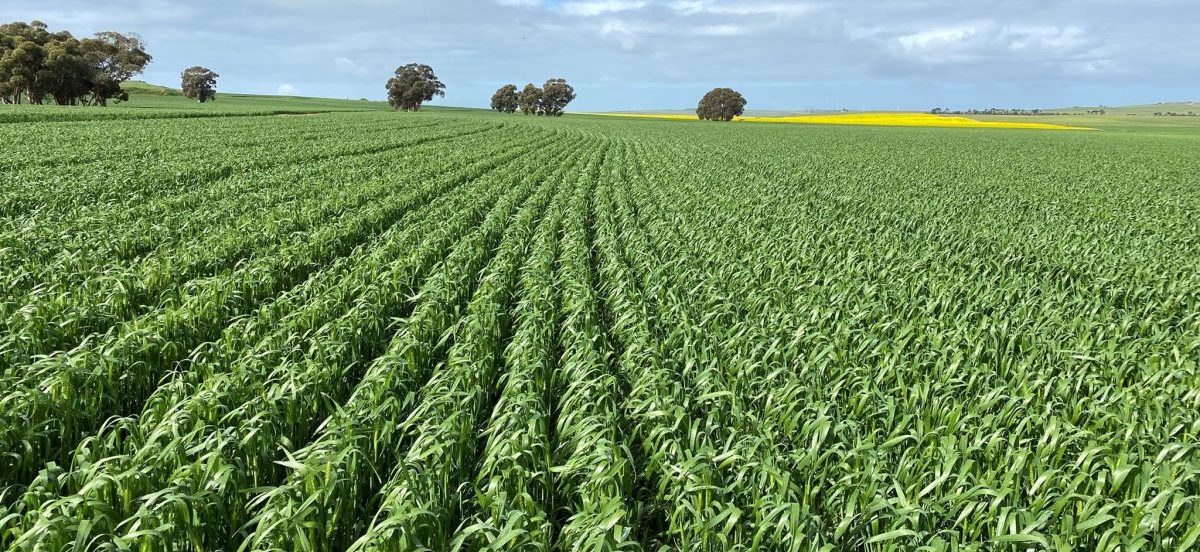
Conditions of wheat crops across Australia are mixed this year, with this crop of Vixen wheat at Badgingarra in WA among the better ones. Photo: Luke Freeman, Hi-Tech Ag Solutions
PRICES for feedgrain were mostly steady in the northern market and firmer in the south as trading interest migrates to new-crop slots.
While exporters have mostly ratcheted back their buying in order to gauge the size and quality of the Northern Hemisphere harvest, the domestic market is waiting for a clearer picture on the local crop.
The big variable for the coming week will be how much rain falls in New South Wales, where crops range in condition from struggling because of waterlogging to excellent.
Consumers are generally seen as well covered into new crop, and buyer selling is expected to be minimal in the closing weeks of winter.
| Prompt today | Aug 4 | New-crop | |
| Barley Downs | $390 | $390 | $375 |
| SFW wheat Downs | $410 | $410 | $402 |
| Sorghum Downs | $360 | $350 | $330 |
| Barley Melbourne | $388 | $390 | $390 |
| ASW Melbourne | $428 | $418 | $410 |
| SFW Melbourne | $420 | $408 | nq |
Table 1: Indicative prices in Australian dollars per tonne.
North flat
Big news in the north this week is the disruption to rail services following Tuesday’s derailment east of Goondiwindi.
Grain Central understands the incident means around 38 wagons of wheat have to be transferred into trucks, which continue to be in tight supply now that they are supplying three rather than one road-only export sites in Brisbane.
 Patchy rain fell in Queensland’s grain-growing areas last week, with totals to 9am today including: Dalby 16mm; Emerald 26mm; Jondaryan 17mm; Springsure 14mm, and Surat 6mm.
Patchy rain fell in Queensland’s grain-growing areas last week, with totals to 9am today including: Dalby 16mm; Emerald 26mm; Jondaryan 17mm; Springsure 14mm, and Surat 6mm.
In central and northern NSW, totals included: Coonabarabran 72mm; Forbes 30mm; Gunnedah 41mm; Moree 15mm; Narrabri 42mm, Quirindi 56mm, and Walgett 22mm.
In the coming week, around 15-50mm is forecast for much of the Australian grainbelt excluding Central Queensland.
Consumers are watching with interest the outlook for a wet spring including harvest in southern Queensland and the northern half of NSW, which will put price pressure on SFW-type wheat, of which there is still plenty in up-country storages.
“Most of the market’s looking at January forward, and there’s not a lot of liquidity.
“To find volume selling, you need to be paying $415-$420 for SFW wheat, and the consumer isn’t prepared to pay that,” one trader said.
Cottonseed delivered Downs is trading at around $350/t in the prompt market, roughly the same as the new-crop market opening in April.
“We’re not getting local grower engagement at these levels now that the market’s back a bit,” another trader said.
Southern growers disengaged
Trade sources report crops in Victoria are the most even in condition, and likely to achieve above-average yields if spring is kind.
In South Australia, Pinion Advisory agribusiness consultant Rebekah Starick said the state’s crop is “very patchy”, and harvest is expected to start in late October.
“It was a late start for some parts of the cropping zone, particularly the Upper North,” Ms Starick said.
While crops are looking good in some regions, including parts of the Murray-Mallee and Upper South East, others are in need of a top-up rain, and are forecast to get it in coming days.
Alfie reckons Beckom Wheat Sth of Nhill looking great. pic.twitter.com/DjSF28ZmtE
— Marty Colbert (@colbert_marty) August 11, 2022
ABOVE: Victoria has plenty of crops, like this one at Nhill, that are well advanced and have good yield potential.
Ahead of that, she said growers and the trade were watching Northern Hemisphere events.
“August is the peak for the Northern Hemisphere crop information coming out, and we have this small amount of Ukraine exports coming out too.
“Generally, once we get into September, people have a better sense about what the crops are like, and the focus shifts to there being an uptick in the markets.”
“For the moment, growers will hang tight, and get out of the frost window.”
On current-crop, bids for wheat delivered to Mid North and Murray Bridge sites are sitting at above $400/t, with barley at $350/t.
Very little grain remains in the wider Port Adelaide zone in grower or bulk storages following a hefty export program.
“There’s not a lot of grain sitting on farm.”
Trade sources say Victoria is likewise running down its stocks, but NSW is thought to have a big carry-out, in part because of the logistics issues its ports have faced this year.
“The old-crop market is still ticking away, and there are still vessels being loaded,” one trader said.
“Vic’s carry-out will be reasonably tight, and what’s left we’re expecting to see in the market in Sep-Oct.
“The consumer is feeling pretty comfortable; they’re starting to think about new crop, but nobody’s going hammer and tongs at it yet.”
Grain Central: Get our free news straight to your inbox – Click here
